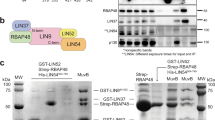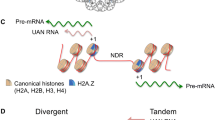Abstract
Maximal transcription of a prototypical cell cycle controlled histone H4 gene requires a proliferation-specific in vivo genomic protein/DNA interaction element, Site II. Three sequence-specific transcription factors interact with overlapping recognition motifs within Site II: interferon regulatory factor IRF-2 (HiNF-M), the putative H4 subtype-specific protein H4TF-2 (HiNF-P), and HiNF-D which represents a complex of the homeodomain protein CDP/cut, CDC2, cyclin A and pRB. However, natural sequence variation in the Site II sequences of different human H4 genes abolishes binding of specific trans-acting factors; the functional consequences of these variations have not been investigated. To address the precise contribution of H4 promoter factors to the level of H4 gene transcription, we performed a systematic mutational analysis of Site II transcriptional motifs. These mutants were tested for ability to bind each of the Site II cognate proteins, and subsequently evaluated for ability to confer H4 transcriptional activity using chimeric H4 promoter/CAT fusion constructs in different cell types. We also analyzed the effect of over-expressing IRF-2 on CAT reporter gene expression driven by mutant H4 promoters and assessed H4 transcriptional control in cells nullizygous for IRF-1 and IRF-2. Our results show that the recognition sequence for IRF-2 (HiNF-M) is the dominant component of Site II and modulates H4 gene transcription levels by 3 fold. However, the overlapping recognition sequences for IRF-2 (HiNF-M), H4TF-2 (HiNF-P) and CDP/cut (HiNF-D) together modulate H4 gene transcription levels by at least an order of magnitude. Thus, maximal activation of H4 gene transcription during the cell cycle in vivo requires the integrated activities of multiple transcription factors at Site II. We postulate that the composite organization of Site II supports responsiveness to multiple signalling pathways modulating the activities of H4 gene transcription factors during the cell cycle. Variations in Site II sequences among different H4 genes may accomodate differential regulation of H4 gene expression in cells and tissues with unique phenotypic properties.
Similar content being viewed by others
References
Stein GS, Stein JL & Marzluff, WF (eds) (1984), Histone Genes, John Wiley & Sons, New York
Osley MA (1991) Annu. Rev. Biochem. 60: 827–861
Wolfe SA & Grimes SR (1993) J. Cell Biochem. 53: 156–160
Doenecke D, Albig W, Bouterfa H & Drabent B (1994) J. Cell. Biochem. 54: 423–431
Bouterfa HL, Piedrafita, FJ, Doenecke D & Pfahl M (1995) DNA Cell Biol. 14: 909–919
Eilers A, Bouterfa H, Triebe S & Doenecke D (1994) Eur. J. Biochem. 223: 567–574
Wolfe SA, van Wert JM & Grimes, SR (1995) Biochem. 34: 12461–12469
Duncliffe KN, Rondahl ME & Wells JR (1995) Gene 163: 227–232
Bauer–Hofmann R & Alonso A (1995) Nucleic Acids Res. 23: 5034–5040
Sun JM, Ferraiuolo R & Davie JR (1996) Chromosoma 104: 504–510
Sun JM, Penner CG & Davie JR (1993) FEBS Lett. 331: 141–144
Kaludov NK, Pabon–Pena L & Hurt MM(1996) Nucleic Acids Res. 24: 523–531
Bowman TL & Hurt MM (1995) Nucleic Acids Res. 23: 3083–3092
Ivanova VS, Hatch CL & Bonner WM (1994) J. Biol. Chem. 269: 24189–24194
Hatch CL & Bonner WM (1995) DNA Cell Biol. 14: 257–266
Naeve GS, Zhou Y & Lee AS (1995) Nucleic Acids Res. 23: 475–484
Takami Y & Nakayama T (1995) Biochim. Biophys. Acta 1264: 29–34
Oswald F, Dobner T & Lipp M (1996) Mol. Cell Biol. 16: 1889–1895
el–Hodiri HM & Perry M (1995) Mol. Cell Biol. 15: 3587–3596
Hinkley C & Perry M (1992) Mol. Cell Biol. 12: 4400–4411
Martinelli R & Heintz N (1994) Mol. Cell Biol. 14: 8322–8332
Stein GS, Stein JL, van Wijnen AJ & Lian JB (1994) J. Cell Biochem. 54: 393–404
Albig W, Kardalinou E, Drabent B, Zimmer A & Doenecke D (1991) Genomics 10: 940–948
Drabent B, Kardalinou E, Bode C & Doenecke D (1995) DNA Cell Biol. 14: 591–597
Plumb M, Stein J & Stein G (1983) Nucleic Acids Res. 11: 2391–2410
Ramsey–Ewing AL, van Wijnen AJ, Stein GS & Stein JL (1994) Proc. Natl. Acad. Sci. USA 91: 4475–4479
Kroeger P, Stewart C, Schaap T, van Wijnen A, Hirshman J, Helms S, Stein G & Stein J (1987) Proc. Natl. Acad. Sci. USA 84: 3982–3986
Kroeger PE, van Wijnen AJ, Pauli U, Wright KL, Stein GS & Stein JL (1994) J. Cell Biochem. 57: 191–207
Wright KL, Birnbaum MJ, van Wijnen AJ, Stein GS & Stein JL (1995) J. Cell Biochem. 58: 372–379
Birnbaum MJ, Wright KL, vanWijnen AJ, Ramsey-Ewing AL, Bourke MT, Last TJ, Aziz F, Frenkel B, Rao BR, Aronin N, Stein GS & Stein JL (1994) Biochem. 34: 7648–7658
Pauli U, Chrysogelos S, Stein G, Stein J & Nick H (1987) Science 236: 1308–1311
vanWijnen AJ, Ramsey–Ewing AL, Bortell R, Owen TA, Lian JB, Stein JL & Stein GS (1991) J. Cell Biochem. 46: 174–189
van Wijnen AJ, van den Ent FMI, Lian JB, Stein JL & Stein GS (1992) Mol. Cell Biol. 12: 3273–3287
Shakoori R, van Wijnen AJ, Cooper C, Aziz F, Birnbaum M, Reddy GPV, DeLuca A, Grana X, Giordano A, Lian JB, Stein JL, Quesenberry P & Stein GS (1995) J. Cell Biochem. 59: 291–302
van den Ent FMI, van Wijnen AJ, Lian JB, Stein JL & Stein GS (1993) Cancer Res. 53: 2399–2409
Vaughan PS, Aziz F, van Wijnen AJ, Wu S, Harada H, Taniguchi T, Soprano KJ, Stein JL & Stein GS (1995) Nature 377: 362–365
Tanaka N, Kawakami T & Taniguchi T (1993) Mol. Cell Biol. 13: 4531–4538
Dailey L, Roberts SB & Heintz N (1988) Genes Dev. 2: 1700–1712
van Wijnen AJ, Aziz F, Grana X, DeLuca A, Desai RK, Jaarsveld K, Last TJ, Soprano K, Giordano A, Lian JB, Stein JL & Stein GS (1994) Proc. Natl. Acad. Sci. USA 91: 12882–12886
van Wijnen AJ, van Gurp MF, de Ridder M, Tufarelli C, Last TJ, Birnbaum M, Vaughan PS, Giordano A, Krek W, Neufeld EJ, Stein JL & Stein GS (1996) Proc. Natl. Acad. Sci. USA 93: 11516–11521
Ausubel FM, Brent R, Kingston RE, Moore DD, Seidman JG, Smith JA, Struhl K (eds)(1987): Current Protocols in Molecular Biology New York: John Wiley & Sons, Inc
LaBella F, Sive HL, Roeder HG & Heintz N(1988) Genes Dev. 2: 32–39
Author information
Authors and Affiliations
Rights and permissions
About this article
Cite this article
Aziz, F., van Wijnen, A.J., Vaughan, P.S. et al. The integrated activities of IRF-2 (HiNF-M), CDP/cut (HiNF-D) and H4TF-2 (HiNF-P) regulate transcription of a cell cycle controlled human histone H4 gene: mechanistic differences between distinct H4 genes. Mol Biol Rep 25, 1–12 (1998). https://doi.org/10.1023/A:1006888731301
Issue Date:
DOI: https://doi.org/10.1023/A:1006888731301




